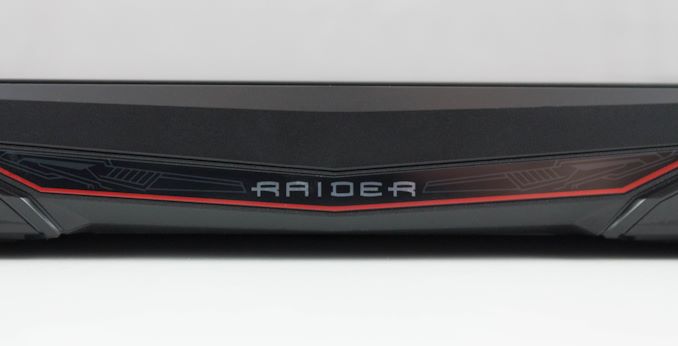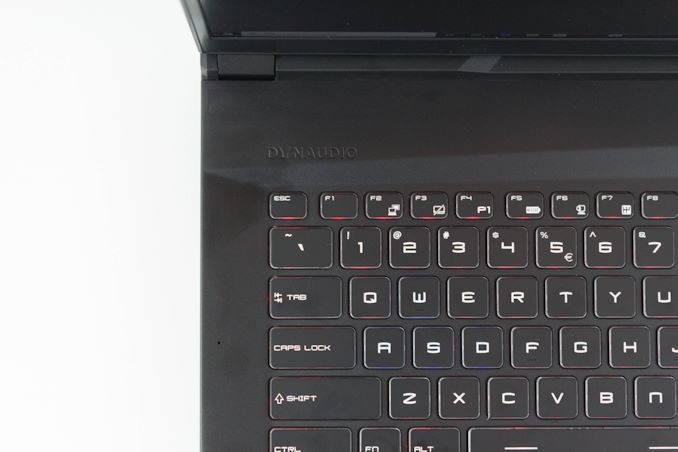The MSI GE75 Raider Laptop Review: Core i9 and RTX 2080 Performance
by Brett Howse on July 12, 2019 8:00 AM ESTFinal Words
MSI has been laser focused on the gaming market for several years, and have been one of the manufacturers to see the growth potential that the gaming market provided. Their laptops share a similar design philosophy, and offer one of the most premium takes on the gaming laptop market around. The GE75 Raider continues that trend, offering much of what the GT series provides, while coming in at hundreds of dollars less than the GT range, and offering a laptop that is much more portable than the GT lineup, which is MSI’s desktop replacement lineup.
The aluminum top shell and keyboard deck provide the premium metal feel you’d expect, while the plastic bottom doesn’t get in the way since most of the time you’ll never see it. The red accents on the lid, coupled with MSI’s dragon logo, are subtle enough that the styling works quite well, while still keeping this laptop looking like it is cut from the same cloth as MSI’s other gaming systems.
Opening the lid, the GE75 Raider sports the modern thin bezel design, and features on the of the best keyboards around, with per-key RGB backlighting and plenty of customization. The SteelSeries keyboard offers great feel, and while the key caps could be better, it still offers a great experience, especially coupled with the generously sized, and accurate, trackpad.
Gaming laptops are all about performance, and the GE75 Raider delivers in spades. It features the first eight-core CPU we’ve ever tested in a notebook, and even the base model ships with a very stout six-core unit. The Core i7-9750H and Core i9-9880H both provide plenty of grunt to keep the GPU fed.
NVIDIA’s latest GPU lineup for laptops doesn’t offer the same performance jump from the previous generation that we’ve come to expect, but the RTX 2060, 2070, and 2080 offered in the GE75 Raider still provide the most single-card performance available in a laptop. MSI’s GE75 Raider is large enough that they don’t need to use the Max-Q designs either, meaning you’re seeing more performance than you’d see on thinner and lighter gaming laptops, with of course the tradeoff of mobility.
The 1920x1080 144 Hz IPS display is a masterpiece, offering some of the best color accuracy we’ve seen on any laptop, and MSI’s True Color software lets you easily customize it as needed for practically any scenario. The one missing feature is G-SYNC though, with MSI choosing Optimus over G-SYNC, and in a gaming laptop, that’s likely the wrong choice. Gaming is still smooth, thanks to the 144 Hz display, but variable refresh rate is a wonderful technology that is sadly missing here.
The tradeoff of G-SYNC should be better battery life, but MSI only outfits the GE75 Raider with a 65 Wh battery, and as such the battery life is middling at best, which is expected in something targeted at gaming. The Optimus isn’t enough to overcome the smaller battery, especially when the competition from Acer offers the user a choice of G-SYNC or Optimus through a hardware multiplexer, which is a solution any gaming laptop manufacturer should emulate.
But the overall GE75 package is solid. The performance is top-notch. The design is pleasing and functional. The keyboard customization is wonderful. MSI tends to charge a premium for their machines, and that trend does continue here, but thanks to the wide range of options, the GE75 Raider fills a pretty wide range of budgets, from $1799 at the bottom end to $3399 at the top, and even the bottom end of the range still comes with a respectable 512 GB of NVMe storage, a Core i7-9750H, and 16 GB of DDR4. At the top, the pricing is high, but MSI continues to showcase their excellent design and execution, with the GE75 Raider being a worthy contender.













30 Comments
View All Comments
Opencg - Friday, July 12, 2019 - link
I dont trust any of these hybrids. Gaming laptop with what appears to be high end silicon but the clocks and tdp are very gimp.Expect a gimped power system, obviously gimped clocks, gimped ec throttle conditions, gimped vbios throttle limits, poor cooling system cause everyone wants to go thin.
At the end of the day expect all the performance of a 5 year old desktop for way more money.
If you really want something that gives you the performance of the silicon you buy look at clevo.
Opencg - Friday, July 12, 2019 - link
Also expect random issues due to everything I listed where your laptop regularly drops to 1/4 its normal framerate while it throttles.Tom001 - Saturday, July 13, 2019 - link
I agree. I found old games to be very snappy and exelent rates on these so called gaming laptops. @£17 K or USD 3900 you can build a massive 3 in one or even a better budget build PC for a fraction of these gaming laptops with full future / longterm upgrade options. It just makes sense when you then will be able to aquire a proper gaming top quality screen (Which have become quite affordable lately) as its the screen we will be concentrating on all of the time. With a budget build a gamer can accomplish fenominal performance with a decent low priced board and accompaning top end CPU, super fast ssd hard drives (their pricing / cost drop by the day) and a medium GPU Card. Better buy a mid range laptop for work with excellent battery life and then shop around for your budget gaming rig. Amazing specials are on offer every now and again Newegg and Amazon. I'd rather settle for the best affordable monitor HDMI and a proper budget build as I can always connect the laptop screen as a second screen with all of the speed and functionality. Work does come first and then gaming. I guess lol :)Orange_Swan - Sunday, July 14, 2019 - link
which is why I'm going for the laptop + eGPU, for my next computer, probably something like a razor blade or a MacBook Proerple2 - Saturday, August 24, 2019 - link
Gaming on a MacBook Pro is .. well, it's awful. It's not as good as on windows for the few games that are supported, and that assume you find a Mac game in the first place.0ldman79 - Monday, July 15, 2019 - link
Question, when partitioning an SSD like this, does that keep the drive rewrites in that partition or does it still physically spread them out as needed?In other words will a 100GB partition that is used often wear out part of the drive faster than just using the entire drive as one partition?
PeachNCream - Monday, July 15, 2019 - link
Partitioning doesn't adversely confine writing data to a specific portion of the SSD's physical storage area. You can split up your drive in the most nonsense way you want and still reap the benefits of wear leveling that happen behind-the-scenes and beneath any file system/partitioning you define.Ronn91 - Friday, July 19, 2019 - link
Thanks a lot for the post. It has helped me get some nice ideas. I hope I will see some really good result soon. https://light-novel.online/evagrey - Wednesday, July 31, 2019 - link
On a serious note, after reading the comments I got a little confused about the laptop. However, to recover the Hacked Roadrunner Email Account you can get help at http://www.emailhelpdesks.co/hacked-roadrunner-ema... in minutes.